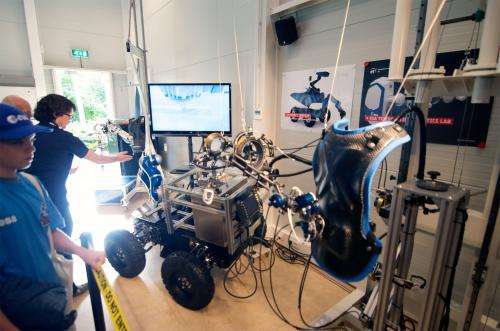Credit: ESA – S. Ferreté Aymerich
Visitors to the ESA Technical Centre's Open Day came face to face with a centaur as they toured the telerobotics laboratory.
Equipped with 4x4 wheels and a pair of fully mobile robot arms, each fitted with grippers and a camera, this still-to-be-finished Interact Robot Centaur is designed for remote operation by astronauts aboard the International Space Station.
It will be put to use in the 'Interact' demonstration next year. The aim is to simulate the way a Mars rover might one day be remotely controlled by a crew orbiting the Red Planet.
Mars is much too far for direct remote control from Earth, but flying astronauts around the planet would overcome the problem of time delay, extending human intelligence and intuition to planetary exploration without the danger and expense of landing.
The outdoor test campaign is due to take place next year, using a control system already aboard the Station for the lab's Haptics-1 experiment to assess the use of force-feedback in weightlessness.
A wearable control exoskeleton can also be seen on the right side of the picture.
Established in 2009 at ESA's technical heart in Noordwijk, the Netherlands, ESA's Telerobotics & Haptics Lab is developing technologies for advanced human-machine interaction, extending the human sense of touch to space and planetary environments.
Provided by European Space Agency
























